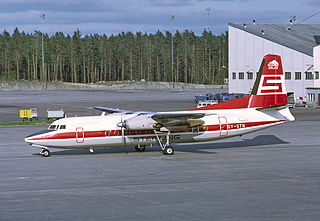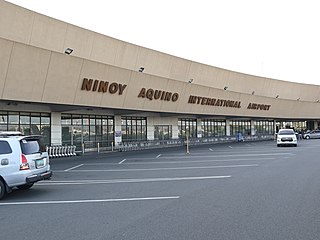
Ninoy Aquino International Airport, formerly known as Manila International Airport, is the airport serving Manila and its surrounding metropolitan area. Located along the border between the cities of Pasay and Parañaque, about 7 kilometers (4.3 mi) south of Manila proper and southwest of Makati. NAIA is the main international gateway for travellers to the Philippines and serves as a hub for Cebgo, Cebu Pacific, PAL Express, and Philippine Airlines, as well as a base for Philippines AirAsia. It is managed by the Manila International Airport Authority (MIAA), an attached agency of the Department of Transportation (DOTr).

Francisco Bangoy International Airport, also commonly known as Davao International Airport, is the main airport serving Davao City and the entire Davao Region in the Philippines. It is the busiest airport on the island of Mindanao and the third busiest in the Philippines after Ninoy Aquino International Airport in Metro Manila and Mactan–Cebu International Airport in Lapu-Lapu City. The airport has a single 3,000-meter precision runway.
XiamenAir, formerly known as Xiamen Airlines, is a Chinese passenger airline based in Xiamen, Fujian Province. The airline operates scheduled passenger flights out of Xiamen Gaoqi International Airport and, to a lesser extent, Beijing Daxing International Airport, Fuzhou Changle International Airport and Hangzhou Xiaoshan International Airport. The airline is owned by China Southern Airlines (55%), Xiamen Construction and Development Group (34%), and Fujian Investment & Development Group (11%). Xiamen Airlines holds a 99.47% stake in Hebei Airlines and a 60% stake in Jiangxi Airlines.

Zest Airways, Inc., operated as AirAsia Zest, was a low-cost airline based at the Ninoy Aquino International Airport in Pasay, Metro Manila in the Philippines. It operated scheduled domestic and international tourist services, mainly feeder services linking Manila and Cebu with 24 domestic destinations in support of the trunk route operations of other airlines. In 2013, the airline became an affiliate of Philippines AirAsia operating their brand separately. Its main base was Ninoy Aquino International Airport, Manila.
Pacific Airways Corporation operating as Pacificair is a charter airline based in Manila in the Philippines. It operates scheduled passenger flights, as well as air taxi services, and agricultural work. Its main base is Ninoy Aquino International Airport, Manila.

Southwest Airlines Flight 1248 was a scheduled passenger flight from Baltimore, Maryland, to Chicago, Illinois, continuing on to Salt Lake City, Utah, and then to Las Vegas, Nevada. On December 8, 2005, the airplane slid off a runway at Chicago-Midway while landing in a snowstorm and crashed into automobile traffic, killing a six-year-old boy.

General Santos International Airport also known as Tambler Airport, is an alternate international airport located in the city of General Santos, Philippines serving the greater area of Soccsksargen. Situated in Fatima, General Santos, it is the largest airport on the island of Mindanao and is officially classified as an international airport by the Civil Aviation Authority of the Philippines (CAAP), a government bureau which is responsible for the management and operations of General Santos International Airport and all other airports in the country except regular international airports.

Southwest Airlines Flight 1455 was a scheduled passenger flight from McCarran International Airport, Las Vegas, Nevada to Burbank-Glendale-Pasadena Airport, Burbank, California, that overran the runway during landing on March 5, 2000. The aircraft, a Boeing 737-3T5, registration N668SW, came to rest on a city street adjacent to a gas station. The National Transportation Safety Board found that the incident was due to the pilots attempting to land with excessive speed. They also found that the air traffic controller placed them in a position from which their only option was a go around. Two of the passengers were seriously injured, and there were many minor injuries. As a result of the incident, the airport installed an Engineered Materials Arrestor System (EMAS) at the east end of the incident runway. The aircraft was written off, making the incident the 10th hull loss of a Boeing 737-300. This was the first major accident in the airline's 29-year history.

Air Philippines Flight 541 was a scheduled domestic flight operated by Air Philippines from Ninoy Aquino International Airport in Manila to Francisco Bangoy International Airport in Davao City. On April 19, 2000, the Boeing 737-2H4 crashed in Samal, Davao del Norte while on approach to the airport, killing all 124 passengers and 7 crew members. It remains the deadliest air disaster in the Philippines and the third deadliest accident involving the Boeing 737-200, after Mandala Airlines Flight 091, which crashed 5 years later, and Indian Airlines Flight 113.
PAL Express, legally known as Air Philippines Corporation and formerly branded as Air Philippines and Airphil Express, is a wholly owned subsidiary airline of Philippine Airlines which is under its ownership. It is PAL's regional brand, with services from its hubs in Manila, Clark, Cebu, and Davao.

On 22 December 2009, an American Airlines Boeing 737-800, operating American Airlines Flight 331 and carrying 148 passengers and six crew, overran runway 12 on landing at Kingston in poor weather. The plane continued on the ground outside the airport perimeter and broke apart on the beach, causing injuries.

Laoag International Airlines Flight 585 was a scheduled flight operated by Laoag International Airlines from Manila to Basco, Philippines via Laoag. On November 11, 2002, the Fokker F-27 Friendship crashed into Manila Bay shortly after takeoff from Ninoy Aquino International Airport. Of the 34 passengers and crew on board, 15 survived.

On September 1, 2018, UTair Flight 579, a Boeing 737-800 on a scheduled domestic flight from Moscow to Sochi, Russia, with 164 passengers and 6 crew, overran the runway and caught fire while landing at Sochi, injuring 18 occupants. One airport employee died of a heart attack.

Ninoy Aquino International Airport Terminal 1 is an airport terminal at Ninoy Aquino International Airport (NAIA) in Parañaque, Metro Manila, Philippines. NAIA is the main airport serving Manila and its surrounding metropolitan area. Located along the border between the cities of Pasay and Parañaque and opened in 1981, NAIA 1 has an area of 67,000 square meters (720,000 sq ft) and is the first higher-capacity airport terminal in the Philippines and the second oldest-terminal in the NAIA complex after Terminal 4, or the Manila Domestic Passenger Terminal.

Pegasus Airlines Flight 2193 was a scheduled domestic passenger flight from Izmir to Istanbul in Turkey operated by Pegasus Airlines. On 5 February 2020, the Boeing 737-800 operating the route skidded off the runway while landing at Istanbul-Sabiha Gökçen International Airport, Turkey. Three people were killed, 179 people were injured, and the aircraft was destroyed. It was the first fatal accident in the airline's history. The accident came less than a month after another Pegasus Airlines accident involving a Boeing 737 skidding off the runway at the same airport.

On 1 September 2019, a Beechcraft King Air 350 crashed into a tourist resort in Calamba, Laguna, Philippines while performing a medevac flight from Dipolog to Manila. All nine occupants aboard were killed in the crash.

Air India Express Flight 1344 was a scheduled international flight on 7 August 2020 from Dubai, United Arab Emirates, to Kozhikode, India, landing at Calicut International Airport. The flight was part of the Vande Bharat Mission to repatriate Indian nationals stranded due to the COVID-19 pandemic. The flight crew aborted two landing attempts because of heavy rain and tailwind. On the third landing attempt, the aircraft touched down on runway 10, but skidded off the end of the tabletop runway and slid down a 9–10.5 m (30–35 ft) slope, killing 19 passengers and both pilots. The four cabin crew members and 165 passengers survived, of whom all but two were injured. This was the second fatal accident involving Air India Express, after the 2010 Mangalore crash.














